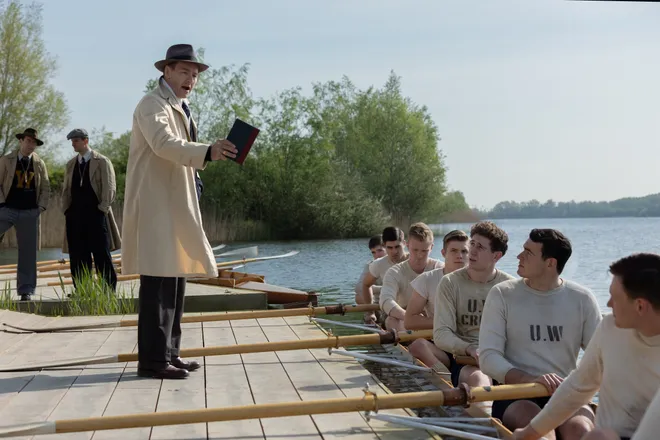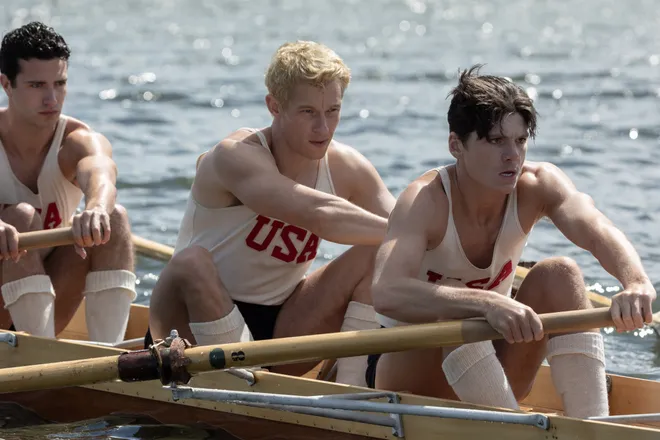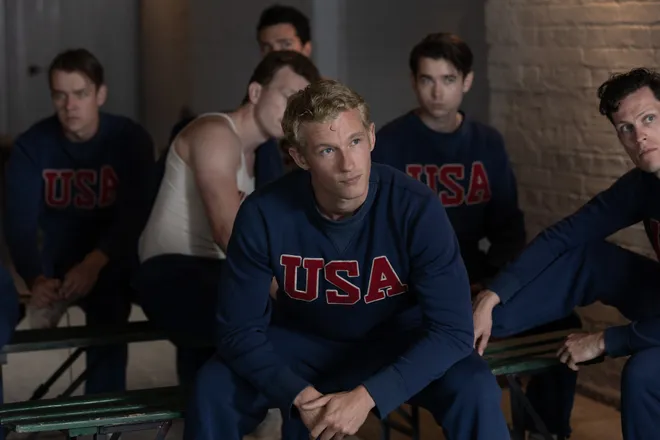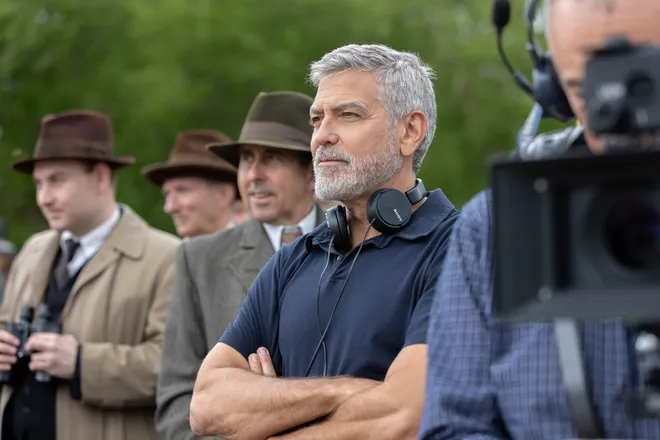Fact checking 'Boys in the Boat': How much of George Clooney's crew drama is true?
Ten years ago, a new book's tale of grit and adventure quickly caught fire with critics and readers alike. That story is now George Clooney's latest directorial effort, "The Boys in the Boat" (now in theaters).
Set in the hardscrabble 1930s, the movie focuses on Joe Rantz (Callum Turner), a poor kid whose attendance at the University of Washington is partly funded by his ability to row for the school's crew team. "Boys" takes us on that team's improbable journey to victory over better-funded collegiate rivals and, ultimately, Hitler's German team at the 1936 Berlin Olympics. That true story is also chronicled in the 2016 "Frontline" documentary "The Boys of '36," streaming now on PBS.org and YouTube.
But as is the case with nearly every feature film developed from a non-fiction book, shortcuts and compressions were made to create a taut two-hour movie. So it was with the source material, "The Boys in the Boat: Nine Americans and Their Epic Quest for Gold at the 1936 Berlin Olympics."
Author Daniel James Brown had a few early conversations about the adaptation of his 2013 book with Clooney. "He got the spirit of the story," Brown says, "but I didn't expect him to transcribe the book." Brown sheds light on a few of the biggest differences between book and movie.
USA TODAY interview:How George Clooney finally made an 'exciting' rowing movie with 'The Boys in the Boat'

Was the timeline of the winning University of Washington crew team accurate?
Brown notes the arc of events that culminated in the University of Washington's junior-varsity crew team's victory at the Berlin Olympics spanned three years, but in the movie "it's all compressed into the year 1936, which is the year when everything came together." That strategy "makes sense, unless you're doing a (longer) TV series."
But the compression omits some important details of Rantz's harsh upbringing. "There was a moment in high school, it was a rainy day and the car was packed up with his father, stepmother and stepkids, and they said 'We're leaving, and we're not taking you,'" says Brown. "It's a touchstone of his story, and resulted in it being hard for him to trust people."
Did the University of Washington's coach really favor his junior varsity team over the varsity squad?
Due in part to Rantz's powerful rowing ability, the University of Washington's green junior varsity team was quickly posting faster times than its veteran varsity counterpart, says Brown. As that trend continued over the next few years, the team's coach, Al Ulbrickson (played by Joel Edgerton in the movie), "made the a dramatic decision to send his JV team to the big collegiate contests back east."
The move raised the ire of many school supporters. "It was dangerous because many boosters were invested in varsity crew; some had sons on that team," says Brown. "So it was a very risky thing to do for his future employment."

Did people in the 1930s really watch crew races while sitting on moving bleachers?
A century ago, sports such as rowing and horse racing were national pastimes in the same way football and baseball are today, Brown says. And yes, trains were reconfigured to pull grandstands along the banks of rivers that hosted such contests.
"Spectators on those observation trains could keep a close eye on each race as it unfolded, because a lot of the dynamics of a crew race happen along the way," he says. And in a place such as Poughkeepsie, New York, the site of the big collegiate showdown in the film, the race was four miles long, says Brown.
Did the winning University of Washington crew team really have to raise money to go to the Olympics?
In the movie, the University of Washington's celebration after winning the top collegiate rowing prize is immediately dampened by news that the U.S. Olympic Committee couldn't afford to send the team to Berlin. So a fundraising drive kicked off overnight. "By the next morning, a steering committee had formed, and by that afternoon, students were selling paper badges, calling businesses for donations, and in about 48 hours they had the $5,000 needed for the trip," says Brown.

But the movie's feel-good moment ― when the coach of the University of California-Berkeley team, the Cal Bears, writes a $300 check to wrap up the fundraising ― never happened. "He did say that the Washington team should go, which was bold as they were bitter rivals," Brown says. But he never wrote a check.
Did a sickly University of Washington crew team member really lead the team to a gold medal Olympic victory?
The movie portrays Hume as a socially awkward kid who was the key ingredient in the team's big win in front of a crowd that included furious Nazi leader Adolf Hitler. Hume overcomes an illness to rally his team to victory. "All true," says Brown. "Don Hume was what's called the stroke oar; it's the critical seat as it sets the rhythm for the entire team."
As in the film, Hume contracted a respiratory illness on the ship to Germany, and his condition worsened as the team readied for its races. "Don was very, very sick the day of the finals, and it really was unclear if he'd make it through to the end," Brown says. "His performance speaks for itself."

Did the winning moment at the 1936 Olympics really come down to a photo finish?
At the movie's climax, the closely contested gold medal race ends in a photo finish. The athletes and spectators wait impatiently as a photographer processes the negative to reveal the result.
Not quite, says Brown: "It was an extremely close finish, and no one knew who had won," he says. "There were photos taken (by spectators) of that finish, but I don't have any reason to think they took a photo to determine who won. But it works dramatically; otherwise they'd just be sitting in the boat, waiting."

Disclaimer: The copyright of this article belongs to the original author. Reposting this article is solely for the purpose of information dissemination and does not constitute any investment advice. If there is any infringement, please contact us immediately. We will make corrections or deletions as necessary. Thank you.







